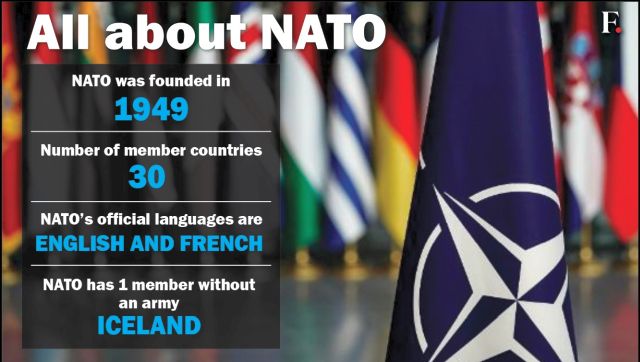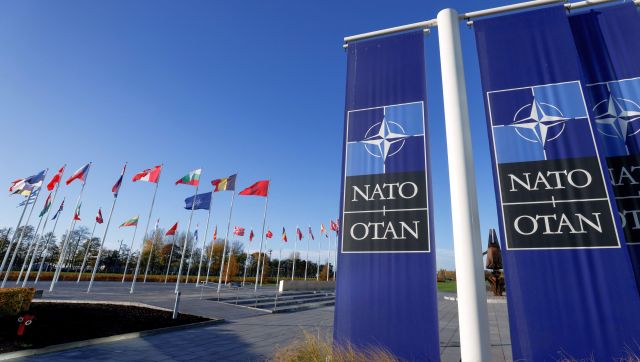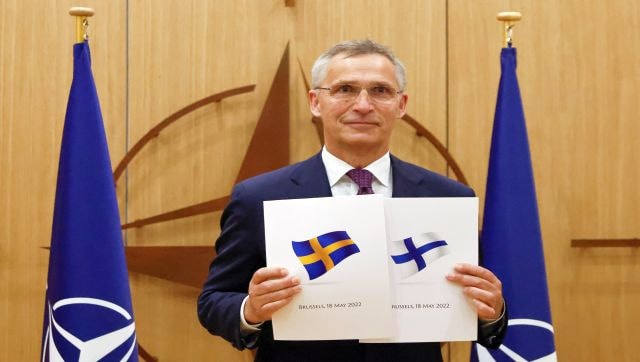As the Russia-Ukraine war wages on, the role of NATO (North Atlantic Treaty Organization) is at the forefront. Analysts have said that the war that Vladimir Putin initiated in February last year was owing to Ukraine’s insistence on wanting to join the military alliance. Now, 401 days into the war, Ukraine’s neighbouring countries — Finland and Sweden — who until now were not a part of the group, have made concrete steps to join NATO. In fact, on Thursday, Turkey finally approved Finland’s application to join NATO, putting an end to months of delays. Sweden’s bid continues to be blocked. On Thursday, the Turkish parliament voted unanimously in favour of Finland’s membership, the last hurdle in the process. Reacting to the news, Finnish president Sauli Niinisto said his country is “now ready to join NATO.” “All 30 NATO members have now ratified Finland’s membership. I want to thank every one of them for their trust and support,” he also said. “Finland will be a strong and capable ally, committed to the security of the Alliance.” “We look forward to welcoming Sweden to join us as soon as possible,” the Finnish president added. We take a closer look at what it entails to become a member of NATO and how the joining of these two nations will change the alliance. What is NATO? NATO was formed in 1949 by 12 countries, including the United States, United Kingdom, Canada and France. The purpose of this bloc was the collective security against the erstwhile Soviet Union. It was America’s first peacetime military alliance outside the western hemisphere. Retired American general and future US president Dwight Eisenhower was tapped to be NATO’s first military leader: the supreme allied commander Europe. Members of the group — which has swelled from 12 at the beginning to 30 at its latest count — are bound by the key principle of collective defence as laid out in
Article 5
. It remains a unique and enduring principle that binds its members together, committing them to protect each other and setting a spirit of solidarity within the Alliance. [caption id=“attachment_12383262” align=“alignnone” width=“640”] Graphic: Pranay Bhardwaj[/caption] What this means is that an attack against one ally is considered as an attack against all allies. Russia has always been against NATO, stating that the collective was a threat to the country’s security. It has vehemently opposed Ukraine’s request to join the alliance, fearing this would encroach too closely on its territory. It has also opposed Finland and Sweden joining the alliance, saying that such an action “would have serious military and political consequences”. What countries are part of NATO? As of today, NATO has 30 members. They are made up of 12 founding members: Belgium, Canada, Denmark, France, Iceland, Italy, Luxembourg, the Netherlands, Norway, Portugal, the United Kingdom and the United States.
Graphic: Pranay Bhardwaj[/caption] What this means is that an attack against one ally is considered as an attack against all allies. Russia has always been against NATO, stating that the collective was a threat to the country’s security. It has vehemently opposed Ukraine’s request to join the alliance, fearing this would encroach too closely on its territory. It has also opposed Finland and Sweden joining the alliance, saying that such an action “would have serious military and political consequences”. What countries are part of NATO? As of today, NATO has 30 members. They are made up of 12 founding members: Belgium, Canada, Denmark, France, Iceland, Italy, Luxembourg, the Netherlands, Norway, Portugal, the United Kingdom and the United States.
As well as Greece, Türkiye, Germany, Spain, Czech Republic, Hungary, Poland, Bulgaria, Estonia, Latvia, Lithuania, Romania, Slovakia and Slovenia, Albania, Croatia, Montenegro and North Macedonia. How to become a member of NATO? Based on Article 10 of the alliance’s charter, NATO follows an “open door” policy for countries seeking membership. The article says that the NATO members can invite any European country to join the alliance in order to contribute to the security of the North Atlantic region. However, the road to becoming a part of the alliance is long and winding and requires the approval of all 30 existing allied countries. When a country seeks to join the alliance, NATO first sends an official invitation to that country. This is followed by a seven-step process. The first step involves NATO experts and representatives of the invited country meeting in Brussels and holding talks on the political, legal and military requirements and obligations to be fulfilled to join the alliance. Following this, the invited country sends an official letter of intent to NATO general-secretary and declares that accepts the obligations and commitments of NATO membership. If reforms are to be made, a calendar of reforms is also laid out in this letter. [caption id=“attachment_12383302” align=“alignnone” width=“640”] Flags fly outside NATO headquarters in Brussels, Belgium. Reuters[/caption] Following the founding agreement of NATO being updated, then each country begins its ratification process. The approval process differs from country to country. For instance, a two-thirds vote of the Senate is required for approval in the US, while a formal vote in the UK parliament is not required. The fifth step to becoming a member is a notification to the US, which hosts the treaty. When all these stages are completed in step six, the NATO secretary-general invites the new member to join the alliance. Finally, the new member completes its own national legal process and submits its accession document to the US, and becomes a NATO member.
Flags fly outside NATO headquarters in Brussels, Belgium. Reuters[/caption] Following the founding agreement of NATO being updated, then each country begins its ratification process. The approval process differs from country to country. For instance, a two-thirds vote of the Senate is required for approval in the US, while a formal vote in the UK parliament is not required. The fifth step to becoming a member is a notification to the US, which hosts the treaty. When all these stages are completed in step six, the NATO secretary-general invites the new member to join the alliance. Finally, the new member completes its own national legal process and submits its accession document to the US, and becomes a NATO member.
Why Finland and Sweden want to join NATO? The two countries have a long history of being neutral and staying out of military alliances. However, this stance changed after the Russia-Ukraine war began in February 2022. One needs to understand that
Russia shares a border with Finland
— some 1,340 km. While the Vladimir Putin-led country shares no land border with Sweden, it has a major presence along the coast of the Baltic Sea. According to experts, Vladimir Putin’s actions have shattered a long-standing sense of stability in northern Europe, leaving Sweden and
Finland
feeling vulnerable. Finnish ex-prime minister Alexander Stubb had said joining the alliance was a “done deal” for his country as soon as Russian troops invaded Ukraine on 24 February. For the Finns, events in Ukraine served up a memory that has haunted them for years. The Soviets had invaded Finland in late 1939. For more than three months the Finnish army put up fierce resistance, despite being heavily outnumbered. They avoided occupation, but ended up losing 10 per cent of their territory. Sweden has also felt endangered in recent years, with several reported airspace violations by Russian military aircraft. [caption id=“attachment_12383342” align=“alignnone” width=“640”] NATO Secretary-General Jens Stoltenberg attends a ceremony to mark Sweden’s and Finland’s application for membership in Brussels, Belgium. File image/Reuters[/caption] And with the war, the attitudes of the local populations towards NATO also changed drastically. According to data collated by Statista, in April 2014, only 28 per cent of Sweden’s population said yes to join the alliance. In February 2022, when asked again, the number rose and 41 per cent of the people thought Sweden should join NATO. And in July 2022, this number increased to 64 per cent. Similarly, Finland too saw an attitude change towards joining NATO. In October 2021, only 24 per cent of the people wanted the country to join the alliance. However, in May of 2022, this rose to 76 per cent. It was in June last year that all allies of NATO invited Sweden and Finland and since then the ratification process has been ongoing. While Finland has got the green signal from all 30 members, with Turkey being the last one to give its nod, Sweden’s bid to enter the alliance still faces a roadblock. What would their membership mean? For NATO, Finnish and Swedish membership would bolster their eastern flank and its collective defences in northern Europe. Perhaps the most significant impact would be the stretching of NATO’s border with Russia. Bringing in Finland would more than double the length, adding roughly 800 miles of frontier. And Finland and Sweden together would vastly expand the alliance’s presence in the Baltic Sea and the Arctic Circle. Bringing Finland and Sweden into the fold would also strengthen NATO in the Arctic, a region where Russia has invested heavily in commercial and military infrastructure. Finnish and Swedish accession would bring all Arctic states, except Russia, into NATO, allowing the alliance to pursue a more coherent strategy in the region. For both the countries, a NATO membership would provide them with security cover from Russia. It would mean that the countries would receive the backing of military might of the alliance if Vladimir Putin was to attack them. It’s not known when Finland and Sweden will officially become members of NATO, but it’s bound to anger Russia and tensions are going to run high in the European region. With inputs from agencies Read all the
Latest News
,
Trending News
,
Cricket News
,
Bollywood News
, India News
and
Entertainment News
here. Follow us on
Facebook
,
Twitter
and
Instagram
.
NATO Secretary-General Jens Stoltenberg attends a ceremony to mark Sweden’s and Finland’s application for membership in Brussels, Belgium. File image/Reuters[/caption] And with the war, the attitudes of the local populations towards NATO also changed drastically. According to data collated by Statista, in April 2014, only 28 per cent of Sweden’s population said yes to join the alliance. In February 2022, when asked again, the number rose and 41 per cent of the people thought Sweden should join NATO. And in July 2022, this number increased to 64 per cent. Similarly, Finland too saw an attitude change towards joining NATO. In October 2021, only 24 per cent of the people wanted the country to join the alliance. However, in May of 2022, this rose to 76 per cent. It was in June last year that all allies of NATO invited Sweden and Finland and since then the ratification process has been ongoing. While Finland has got the green signal from all 30 members, with Turkey being the last one to give its nod, Sweden’s bid to enter the alliance still faces a roadblock. What would their membership mean? For NATO, Finnish and Swedish membership would bolster their eastern flank and its collective defences in northern Europe. Perhaps the most significant impact would be the stretching of NATO’s border with Russia. Bringing in Finland would more than double the length, adding roughly 800 miles of frontier. And Finland and Sweden together would vastly expand the alliance’s presence in the Baltic Sea and the Arctic Circle. Bringing Finland and Sweden into the fold would also strengthen NATO in the Arctic, a region where Russia has invested heavily in commercial and military infrastructure. Finnish and Swedish accession would bring all Arctic states, except Russia, into NATO, allowing the alliance to pursue a more coherent strategy in the region. For both the countries, a NATO membership would provide them with security cover from Russia. It would mean that the countries would receive the backing of military might of the alliance if Vladimir Putin was to attack them. It’s not known when Finland and Sweden will officially become members of NATO, but it’s bound to anger Russia and tensions are going to run high in the European region. With inputs from agencies Read all the
Latest News
,
Trending News
,
Cricket News
,
Bollywood News
, India News
and
Entertainment News
here. Follow us on
Facebook
,
Twitter
and
Instagram
.
)